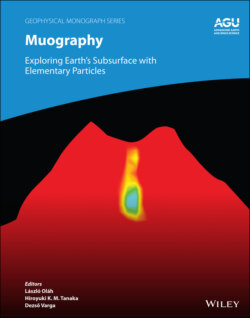Читать книгу Muography - Группа авторов - Страница 29
1.3.3 Phreatic Explosions and Magmatic Eruptions
ОглавлениеThe first successful nuclear emulsion‐based muographic observation system was set up in Asama volcano, Japan, in 2006 (Tanaka et al., 2007a). An image was reconstructed from the muon trajectories that were recorded in the nuclear emulsion, which was placed in a vault created 1 km east of the center of the crater. Topography of the volcanic plug located at the crater floor was estimated from airborne synthetic aperture radar (SAR) measurements both before and after the 2004 eruption (Urabe et al., 2006), which were used for comparison with the high‐density region that indicated a volcanic plug in the muographic image (Fig. 1.6a). The statistical error for the bulk density of this region was 0.04 g/cm3.
Additionally, the 2006 measurement imaged a low‐density region that indicated a vacant magma pathway underneath the volcanic plug, as shown in Fig. 1.6a. The statistical error for the bulk density of this region was 0.2 g/cm3. This low‐density region was interpreted as a porous magma pathway that was plugged by magma deposited on the crater floor, which was created by the following process. After the eruption process was completed in 2004, the magma deposit on the crater floor cooled and solidified, and the magma in the pathway drained away, leading us to speculate that it left a vacant or highly porous pathway. The muographic image captured a structure consistent with this interpretation in the anticipated region below the crater floor. If this space is over‐pressured by future volcanic activities, the plug may explode, rapidly releasing fragments of this magma deposit.
Additional observational data for the Asama volcano has become available since 2008 after the installation of a scintillation detector in a vault created 1.2 km east of the center of the crater with a real‐time reading device (Tanaka et al., 2009b). This muographic observation system was accessible from a remote personal computer (PC) via a wireless local area network (LAN) and the internet. During the observation, Asama erupted on Feb 2, 2009. The system was stable and continued to operate before and after the eruption. Fig. 1.6b shows data averaged over a month before the eruption compared with data averaged over the same time period after the eruption. To clarify the difference between its condition before and after the eruption, a dashed line has been added to indicate the shape of the crater before the eruption. On the other hand, the density of the pathway underneath the crater floor did not show a statistically significant change. Since a petrological study of the 2009 eruption ejecta indicated that the chemical composition of the magma matched that of the volcanic ejecta observed in the 2004 eruption, a plausible scenario for the 2009 eruption has been proposed in the following way (Tanaka et al., 2009b). Magma did not flow up the pathway in the 2009 eruption, and high‐pressure vapor simply blasted through the volcanic plug generated in the 2004 eruption.
Figure 1.6 Muographic image of Asama volcano, Japan (a) and images before and after 2009 eruption (b). The dashed line in (b) indicates the shape of the crater before the eruption. The green‐yellow‐red region in (a) indicates the magma deposit in the crater and the low‐density region (a blue patch) was interpreted as a porous magma pathway.
It is difficult to directly observe phreatic explosions with muography because the gas flow doesn’t generate significant density variations inside a volcano. However, like an example shown above, indirect evidence could be captured as the structural modification as a consequence of phreatic explosion. In contrast with phreatic explosions, magmatic eruptions could be more directly captured with muography. Dense magmatic materials ascend through the highly porous pathway during magmatic eruptions. On June 4, 2013, the eruption alert level had risen from level 1 (signs of volcano unrest) to level 2 (minor eruptive activity) at Satsuma‐Iwojima volcano, Japan. Time sequential muographic images showed the ascent and descent of the magma head, which synchronized to the visual observation timings of volcanic glows during this eruption episode (Tanaka et al., 2014). Currently, the automatic analysis and data visualization system is available for volcano muography (Tanaka et al., 2020c). The resultant muographic images were similar to medical radiographic images. In the field of medical imaging, by taking advantage of recent deep learning techniques, for example, convolutional neural network (CNN), image processing techniques have been highly developed to realize automated medical image analysis and evaluation. A deep learning technique similar to what is used now for medical image processing has been found to be applicable to analyzing time‐sequential muographic images (Nomura et al., 2020).
